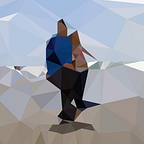Taking a line for a walk
David Hockney is one of my favorite artists. Two years ago, I went to see his exhibition at DeYoung Museum. I love his colossal canvases, delicate drawings, and inventive montages. But I felt very disappointed when I saw his iPad and iPhone drawings.
In his Woldgate charcoal drawings, for example, I see a countryside that is brimming with light and textures, with such intense vitality that one can almost feel the weather and touch the trees. In contrast, the Yosemite iPad drawings appear like unfinished sketches. Pixelated lines waver and fluster, as if they cannot keep up with movements of the hand. Monotonous digital brushes fill the sky with smog and litter the land with rubber bands. Alas!
It leads me to wonder: When a line is drawn on iPad, whose line is it?
The man-in-the-middle between Hockney and his iPad drawings is the creator of that drawing app. Thus creative expressions can be expansive or limited based on the app, and the app creator’s invisible hand guides the artist’s hand whenever he or she draws a line.
Many iPad drawing apps offer a similar conservative approach to drawing, in which they try to emulate traditional media as closely as possible, and in doing so, it re-iterates the old ideas instead of inventing new ones, and misses the true opportunities offered by a new medium. If Magritte now paints a pipe on iPad, perhaps he would call it The Treachery of Pixels instead.
So how should we draw in this paper-less age? I cannot see a future with pseudo-watercolor on retina-paper-thing. I want to imagine a future where artists would create their own lines before they draw them.
When I was an art student, one conceptual technique I learned was to study a master’s drawing, trace out the lines with a finger, and imagine what it’s like to draw those lines: Matisse’s elegance, Klimt’s flourish, Kollwitz’s rigor. This lesson taught me to appreciate the emotive aspect of a line, and even more importantly, that drawing is an active experience.
This idea of an active experience, of an active line, of Paul Klee taking a line for a walk, becomes the basis of a code experiment.
I want to interpret the ideas of drawing with code. I go back and forth between old ideas of drawing and new prospects of code, knowing that the new isn’t always better than the old, but that by studying the tensions between them we may find new modes of expressions.
I started with some naive questions: Can I trace out a master’s drawing not with finger but with code? In what ways can we express a point’s movements and its path? Is it possible to take a concept of drawing a line, and translate it into a function? And can these concepts be put together to form an alternative approach to digital drawing?
The result is a series of code sketches about a single line, whose form corresponds to a simple function( points, parameters ). Nothing too fancy, just simple code to try out simple ideas.
For example, here are some sketches are inspired by basic drawing techniques: using straight line segments to construct a form ( growLine(…) ), restating instead of erasing ( restatedLine(…) ), and hatching to create tones and textures ( hatchingLine(…) ). All these sketches are created using Pt library.
Here are some sketches examine the idea of a brushstroke. Using a combination of parameters (velocity, noise, opacity, oscillation, and so on) to craft a line.
And of course there are imaginary lines, lines that are visible to the mind’s eye and then made visible in code. They are the easiest to do and the hardest to do well. Here are a few examples.
And if these movements of an active line are recorded and put onto a single image, what kinds of drawing would it be? I made a quick web app to test it out. Here are some of my doodles.
As a critic of my own works, I think these code sketches are somewhat interesting but fall short in many ways. It is a simple approach to create unusual brushstrokes, but it is still a bit conservative, it doesn’t take the original idea of an active line far enough. In particular, I feel akin to cheating from time to time when making “generative art”, in which complexity is free but simplicity is elusive. Because loops and recursions are easy, I am always tempted to go with dazzling dramatic things. But if one looks at all sorts of generative art, and then glimpse at this simple drawing by Matisse, it’s easy to see what’s missing: A different way of seeing, a different kind of drama.
Still a long way to go, and many roads not yet taken. Exciting times!
Take a look at Taking a Line for a Walk here, with interactive demos and source code. Also check out some old works based on a similar idea.
And there are many other cool digital drawing projects. Check these out:
- AARON is a classic from 1970s
- Vellum and other projects by David Lu
- Inkscape and other projects by Zach Lieberman
- Drawing Operations by Sougwen Chung
- Harmony by mrdoob
- And many others!
